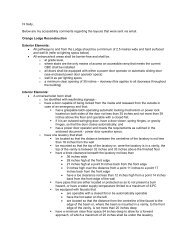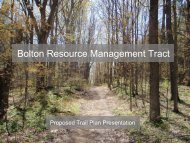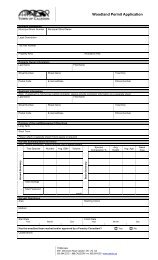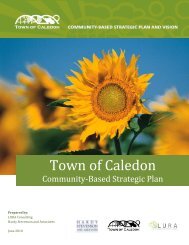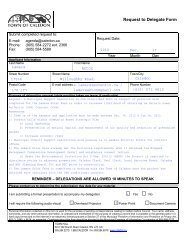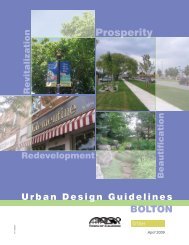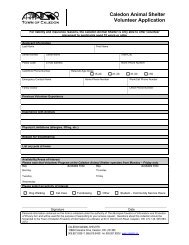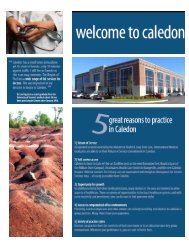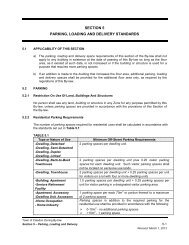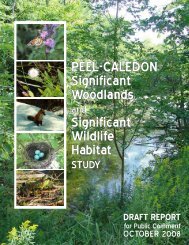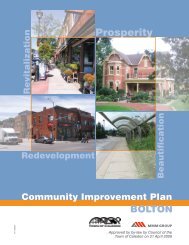Rockside Cultural Heritage Landscape Study - Town of Caledon
Rockside Cultural Heritage Landscape Study - Town of Caledon
Rockside Cultural Heritage Landscape Study - Town of Caledon
Create successful ePaper yourself
Turn your PDF publications into a flip-book with our unique Google optimized e-Paper software.
<strong>Rockside</strong> <strong>Cultural</strong> <strong>Heritage</strong> <strong>Landscape</strong> <strong>Study</strong><br />
<strong>Town</strong> <strong>of</strong> <strong>Caledon</strong><br />
barn to allow for a stone storey below for the housing <strong>of</strong> livestock. Most <strong>of</strong> the area’s<br />
surviving barns show this modification. On the larger farms, such as those <strong>of</strong> Alex<br />
McLaren, John Kirkwood and David Kirkwood, second and sometimes third barns were<br />
added for specialized functions (e.g. stable). The 1871 Census Return noted that John<br />
Kirkwood (Lot 1 Concession 6 WHS) owned 200 acres <strong>of</strong> land, one house and four barns<br />
or stables as well as various carriages, and farm vehicles and equipment that included two<br />
fanning mills and a horse rake. The principal livestock were sheep and swine 4 . His was,<br />
for the area, a particularly prosperous farm.<br />
Other crops <strong>of</strong> some importance in the<br />
area through the mid 19 th century were<br />
peas, oats, potatoes and turnips 5 . The<br />
area was blessed with a large number<br />
<strong>of</strong> sugar maple stands and the<br />
production <strong>of</strong> maple sugar at a number<br />
<strong>of</strong> locations continued well into the 20 th<br />
century (e.g. Rockfort farmstead, Lot 1,<br />
Concession 6 WHS, Inventory #28) 6 .<br />
The 1877 Atlas <strong>of</strong> Peel County map<br />
shows that many <strong>of</strong> the properties had<br />
small orchards.<br />
Remnant orchard at property on Shaw’s Creek Road Other than agriculture some small scale<br />
‘industrial’ activities were undertaken,<br />
such as lime-burning as depicted on the 1877 map along Olde Base Line Road (traces <strong>of</strong><br />
which can still be seen) and stone quarrying, which was largely confined to personal use<br />
for house and/or barn construction e.g. the Frank property (Lot 5 Concession 4 WHS,<br />
Inventory #15) and Rockfort farmstead (Lot 1, Concession 6 WHS, Inventory #28).<br />
As with many marginal agricultural areas employment for the <strong>Rockside</strong> Pioneers <strong>of</strong>ten<br />
had to be found elsewhere to supplement farm income. In the early years this meant<br />
having to go quite far afield to the quarries near Kingston 7 or providing labour for the<br />
construction <strong>of</strong> the Erie Canal. 8 With the development <strong>of</strong> the quarries along the Niagara<br />
Escarpment in the Credit River valley c.1865, including those at nearby Inglewood,<br />
supplemental work could readily be found within the area. As well, provisioning <strong>of</strong> the<br />
substantial workforce for these local quarries provided a ready market for local farmers.<br />
In recent times the farms <strong>of</strong> the area have not been able to compete with larger holdings<br />
elsewhere and agricultural production, with a few exceptions (e.g. the Westerveld hog<br />
farm on Winston Churchill Boulevard (Lot 2 W½, Concession 6 WHS, Inventory #29)),<br />
4 Unterman McPhail and Cuming Associates (UMCA). Rockfort Quarry Site Documentation Report prepared for James<br />
Dick Construction, August 1998, p.6.<br />
5 1860 Agricultural Census for <strong>Caledon</strong>.<br />
6 Interview with Rod and Lorraine Symmes.<br />
7 Robert Crichton, The <strong>Rockside</strong> Pioneers. (Cheltenham: Boston Mills Press, 1977) Chapter 8 (no page numbers).<br />
8 Ibid., Chapter 4.<br />
11



